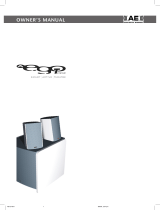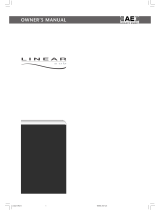
INSTALLATION and OWNERS MANUAL
CUSTOM INSTALL SERIES

Page 1
Thank you for purchasing this Acoustic Energy product. As a valued customer we
would like to keep you up to date with all news and events including new products,
exhibitions and exclusive promotions. To enable us to communicate these exciting
developments please go to our web site - www.acoustic-energy.co.uk - and
complete the ownership registration form.
Perhaps more than any other audio product, speakers are sensitive to installation
so please take a little time to read this manual and to follow, as far as practical, the
installation guidelines it contains. Careful installation will help ensure that your
speakers perform optimally.
This manual covers the Aego Custom Install Series In-wall and In-ceiling speakers.
Following this introduction, the Manual is divided into sections covering,
positioning, connection, installation and listening, We recommend that you read
at least the first three sections carefully before installing and using your speakers.
Warranty and contact information is provided on the last page.
Speakers are relatively delicate precision engineered products that can be
damaged by inappropriate handling. Please take care when unpacking or handling
the speakers not to touch the drivers. Damage to a driver will at best degrade
performance and at worst result in complete failure.
Introduction
1. In-wall Speaker Positioning
Aego Custom Install In-wall speakers are intended to be used in either stereo hi-fi,
multi-channel home theatre or high quality distributed audio systems.
The location of speakers within a listening environment is likely to have more
influence over their subjective performance than any other aspect of installation. It
is worth spending some time considering both the finer points of speaker location,
as well as the larger scale issues of room and speaker layout. Almost certainly your
speakers will be used in one of two applications:
• Stereo or home theatre system where the location of speakers relative to
each other is important.
• Utility “background sound” applications where single speakers are used in
isolation to “cover” a specific area or areas.
These two types of application are covered in the paragraphs below.
Aego Custom Install speakers are NOT magnetically shielded. Magnetically sensitive
equipment or media should be kept at least 1m away.
Contents
Page Section
1 1 In-wall Speaker Positioning
3 2 In-ceiling Speaker Positioning
4 3 In-wall and In-ceiling Speaker Connection
5 4
In-wall and In-ceiling Speaker Installation
6 5 Listening
6 6 Warranty
6 7 Contact Acoustic Energy
1. In-wall Speaker Positioning

Page 2
Mono audio is usually preferable in utility applications but if only stereo is available
multiple speakers in the same room or zone should be connected alternately to the
left and right channels.
In choosing locations for the speakers consider the “coverage” required with respect
to the likely listener positions. Try to ensure that coverage is even and that as
listeners move around the environment the sound from one speaker is gradually
“replaced” by the sound from the next nearest speaker. The overall volume should
be relatively constant.
Mounting Clearances
Clearance depth is required behind the speaker aperture and clearance space
is required on the inside surface of the wall on the longer sides of the speaker
aperture.
The minimum depth clearance behind the speaker aperture, measured from the
outer surface of the wall, is 102mm (4 inches). The minimum
space along the longer
sides of the speaker aperture is 38mm (1.5 inches). Only nominal clearance is
required on the short sides of the speaker aperture - the speaker frame can butt-up
against internal joists if necessary.
Caution
When cutting apertures in walls or ceilings ensure that pipes and cables are
clear. Ensure also that the structure of the walls will safely carry the weight of
the speakers. If you are unsure about any aspect of installation you should seek
professional advice and assistance.
Introduction
1. In-wall Speaker Positioning
2.0 - 3.0m
Left and right
speakers at
screen height.
Centre speaker
below screen.
Diagram One
Surround
speaker above
head height.
Duplicate on
opposite wall.
Subwoofer
Stereo and Home Theatre Speaker Positioning
If a pair of speakers is to be used in a conventional
stereo audio system, or for the front channels in a
home theatre system, they should be positioned
approximately as follows:
• Between 2.0 and 3.0 metres apart (either side of the
screen in home theatre systems).
• In portrait orientation.
• Clear of corners.
• Slightly above, listening head-height (and around
screen height in home theatre systems).
If a speaker is to be used for the centre channel
in a home theatre system it should be positioned
approximately as follows:
• Directly above or below the display screen in
portrait orientation.
If two or more speakers are to be used for the surround
channels in a home theatre system they should be
positioned approximately as follows:
• In-line with and behind (in 7.1 systems) the
listening position.
• At least 0.5m above listening head height.
• In portrait orientation.
Diagram One illustrates general home-theatre in-wall
speaker positioning.
Don’t worry if, thanks to the architecture
or layout of your room, it is not practical
to follow each requirement exactly. The
most important thing is to consider the
practical option and identify the one that
is likely to work best.
Utility Speaker Positioning
If your Aego Custom Install speakers are
to be used as multiple “utility” speakers in
an environment where the intention is to
provide background music they should
be equally distributed throughout the
space and mounted at or just above head
height.
1. In-wall Speaker Positioning

Page 3
2. In-ceiling Speaker Positioning
Aego Custom Install In-ceiling speakers are intended to be used in high quality
distributed audio systems or as surround speakers in home-theatre systems.
The location of speakers within a listening environment is likely to have more
influence over their subjective performance than any other aspect of installation. It
is worth spending some time considering both the finer points of speaker location,
as well as the larger scale issues of room and speaker layout.
Almost certainly your speakers will be used in one of two applications:
• As surround speakers in a Home theatre system where the location of
speakers relative to each other is important.
• In utility “background sound” applications where single speakers are used
in isolation to “cover” a specific area or areas.
These two types of application are covered in the paragraphs below.
Aego Custom Install speakers are NOT magnetically shielded. Magnetically sensitive
equipment or media should be kept at least 1m away.
Home Theatre Speaker Positioning
If two or more speakers are to be used for the surround channels in a home theatre
system they should be positioned approximately as follows:
• In-line with and behind (in 7.1 systems) the listening position.
• All approximately equidistant from the listening position.
• A minimum of 1.5m from the listening position but at least 0.5m away from
walls.
Utility Speaker Positioning
If your Aego Custom Install In-ceiling speakers are to be used as multiple “utility”
speakers in an environment where the intention is to provide background music
they should be equally distributed throughout the space. In-ceiling speakers should
be kept a minimum of 0.5m away from walls.
Mono audio is usually preferable in utility applications but if only stereo is available
multiple speakers in the same room or zone should be connected alternately to the
left and right channels.
In choosing locations for the speakers consider the “coverage” required with respect
to the likely listener positions. Try and ensure that coverage is even and that as
listeners move around the environment the sound from one speaker is gradually
“replaced” by the sound from the next nearest speaker. The overall volume should
be relatively constant.
Mounting Clearances
Clearance depth is required behind the speaker aperture
and clearance space is required on the inside surface of
the ceiling around the speaker aperture.
The minimum depth clearance behind the speaker
aperture, measured from the outer surface of the ceiling,
is 102mm to 153mm (4 to 6 inches) depending on the
specific speaker model. The minimum space around the
speaker aperture is 38mm (1.5 inches).
Caution
When cutting apertures in walls or ceilings ensure that
pipes and cables are clear. Ensure also that the structure
of the walls will safely carry the weight of the speakers.
If you are unsure about any aspect of installation you
should seek professional advice and assistance.
3. In-wall and In-ceiling Speaker Connection

Page 4
Connect positive
Connect negative
Diagram Two
2. In-ceiling Speaker Positioning 3. In-wall and In-ceiling Speaker Connection
Connecting Aego Custom Install speakers to an amplifier is fundamentally a simple
process. However, there are some choices to be made and issues to consider
concerning speaker cable type. Each speaker is fitted with spring connection
terminals designed to accept stripped wires.
Two terminals are fitted to Aego Custom Install In-wall and In-ceiling speakers:
negative and positive. Identification of the terminals is illustrated in Diagram Two
below.
To connect the speakers simply push the terminal lever down, insert the stripped
wire into the hole and release the lever.
Take care not to connect any negative and positive terminals together and “short-
circuit” the amplifier. Always make connections with the amplifier switched off.
Connection Polarity.
It is important to ensure that each speaker is connected with the same polarity.
Positive speaker terminals should always be connected back to amplifier positive
terminals, and negative speaker terminals connected back to amplifier negative
terminals. Performance will be degraded if connections are made with incorrect
polarity.
Cable Choice.
Choice of speaker cable type will be influenced by the
characteristics of other components in your system and
your dealer or distributor will be able to advise. There
are however some simple guidelines to consider:
• Cable runs to each speaker should be kept as
short as possible.
• Short cable runs are especially important if the
cable is of relatively small cross-sectional-area.
• If the cable is advertised as “directional” care
should be taken to ensure that its orientation is as
recommended.
Amplifiers
Aego Custom Install speakers are relatively high
sensitivity speakers that do not require generously
rated power amplifiers for adequate volume levels to be
achieved in an average listening room. A minimum of
25 and maximum of 100 Watts into 8 Ohms per channel
is recommended. They also offer a relatively easy load
to the amplifier and do not make unusually heavy
demands on its power delivery.
No overload protection systems are fitted to Aego
Custom Install speakers so it is possible to cause
damage through over-driving. Such damage can occur
regardless of the power rating of the driving amplifier
and is not covered by any warranty. If ever the sound at
high volumes becomes distorted your speakers are at
risk of damage. In such circumstances the volume must
be reduced.

Page 5
Do not paint grilles while they are fitted and take care that a significant number of
grille perforations do not become blocked. Remove the logo badge and the “scrim”
cloth attached to the back of the grilles (do not paint the back of the grille). Use the
wax paper sheet to protect the scrim. When the paint is dry replace the scrim cloth
by pressing it in to place on the back of the grille. Fit (or refit) the grille by aligning it
with its retaining groove and gently pushing-in from its edges. The logo badge can
be repositioned to suit.
4. In-wall and In-ceiling Speaker Installation
Once you have decided on the positions of each
speaker and established the location of joists, cables or
pipes, use the Cut-out Template included in the pack
to mark out the speaker apertures (remember that the
speaker frame is bigger than the marked hole). Take
care when installing the speakers not to touch the
driver units.
To cut and prepare speaker apertures proceed as
follows:
• Drill a hole at the centre and check using a piece of
wire that the appropriate clearances are available.
• Mark the cut-line and cut the aperture along the
line using the appropriate tools. Clear any loose
debris away
• Run the speaker cable you have chosen to use and
prepare the ends for connection to the speaker.
Acoustic performance can be improved by placing
insulation material in the cavity but leaving clear the
area directly behind the speaker.
Painting
Aego Custom Install speaker outer frames and grilles
may be painted using matt emulsion paint. No primer
coat is necessary. Use two light coats applied with
brush or spray. Use the supplied painting mask when
painting the outer frame.
Fixing clamp
access hole
4. In-wall and In-ceiling Speaker Installation
IR Control
An Infra-Red receiver access hole is provided on the
front panel of Aego Custom Install In-Wall speakers
behind the grille. As supplied, the access hole is closed-
off with a plug. If an IR receiver is to be used, remove the
plug by gently pushing it from the back.
Installing a Speaker
With the aperture cut and prepared the speaker can be
fixed in the wall or ceiling. Remember to connect the
speaker cable before installing the speaker.
Insulation material
within cavity
Diagram Four
Diagram Three
Fixing clamp
access hole

Page 6
4. In-wall and In-ceiling Speaker Installation 4. In-wall and In-ceiling Speaker Installation
Before using your Aego Custom Install speakers for the first time make one
final check of the cables and connections. If all appears well begin listening at
a relatively low level to confirm that the system is operating as expected. Only
increase the volume if you are happy with the sound at low levels. If you are
unhappy, turn the system off and re-check all the cables and connections.
The speakers may take a little time to reach normal operating temperatures and to
“run-in”. Your ears too will take some time to adjust to the new sound so revisiting
the speaker installation is best left for a few days.
Your Acoustic Energy speakers are guaranteed against original defects in materials,
manufacture and workmanship for 1 year from the date of purchase.
Under this warranty Acoustic Energy agrees to repair any defect or, at the
company’s discretion, replace the faulty component(s) without charge for parts
or labour. This warranty does not imply any acceptance by Acoustic Energy or its
agents for consequential loss or damage and specifically excludes fair wear and
tear, accident, misuse or unauthorised modification.
This warranty is applicable in the United Kingdom only and does not in any way
limit the customer’s legal rights. If you have reason to claim under the warranty
please contact your dealer in the first instance
Claims and enquiries under the warranty for Acoustic Energy products purchased
outside the UK should be addressed to the local importers or distributors.
Please retain all original packaging materials for possible future use.
For any sales, technical or spares enquiries contact your local dealer or distributor
first.
Products that display the crossed-out wheeled bin
logo cannot be disposed of as domestic waste
but must be taken to a facility capable of re-
cycling them and appropriately handling
any waste by-products. Contact your local
authority for details of the nearest such facility.
7. Contact
Acoustic Energy Limited
16 Bridge Road
Cirencester
Gloucestershire GL7 1NJ
UK
Tel: +44 (0)1285 654432 (Sales)
+44 (0)1285 656890 (Technical)
Fax: +44 (0)1285 654430
Email: info@acoustic-energy.co.uk
Web: www.acoustic-energy.co.uk
6. Warranty
5. Listening
If the speaker grille is fitted (they are shipped with grilles
removed) remove it by pulling gently from its edges.
Also remove the wax paper sheet and paint mask from
inside the grille. To insert and secure a speaker in a wall
or ceiling proceed as described following. Diagrams
Three and Four illustrate in-ceiling and in-wall speakers
offered-up to an appropriate aperture.
• Ensuring that the fixing clamps are lying flush
against the sides of the speaker, offer the speaker up to
the aperture and hold it in place so that any clearance is
distributed approximately equally around the aperture.
• Using a No. 2 Pozidriv screwdriver via the access
holes tighten the four or six fixing clamps in turn. As the screws begin to tighten
the fixing clamps will turn outwards and begin to make contact with the rear of
the wall or ceiling. Tighten just enough to pull the speaker solidly and securely in
contact around its entire perimeter. Do not over-tighten and Do not use a power
driver or drill.
• Fit the grille by aligning it with its retaining groove and gently pushing from
its edges. The logo badge is removable and can be repositioned to suit.

Acoustic Energy Limited, 16 Bridge Road, Cirencester, Gloucestershire GL7 1NJ.
Tel: +44 (0)1285 654432 (Sales), +44 (0)1285 656890 (Technical). Fax: +44 (0)1285 654430
Email: [email protected]o.uk
Web: www.acoustic-energy.co.uk
Manual Part No. MA3202
CUSTOM INSTALL SERIES
/









